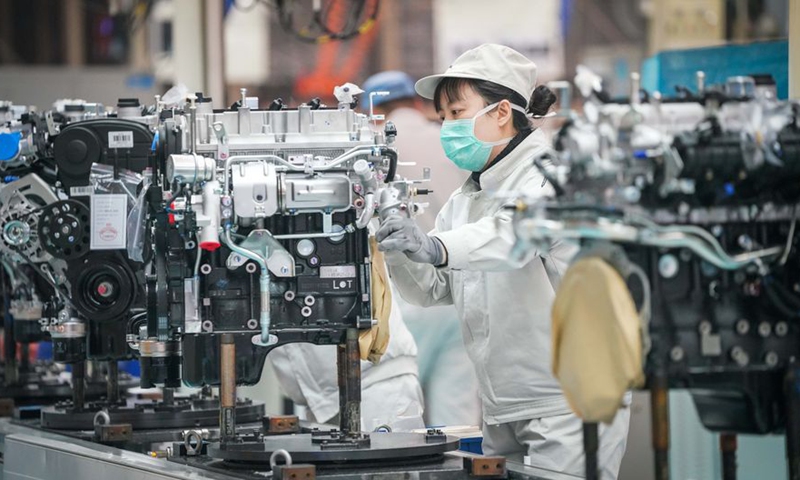
By Chi Jingyi
The American Institute in Taiwan (AIT) and Taiwan’s Representative Office in the US on Friday said the COVID-19 pandemic has exposed the risks of relying too much on a single country or supplier for critical materials.
The two made a joint statement, encouraging partners to bring supply chains closer to home or like-minded economies.
But analysts said that the island of Taiwan’s attempt to restructure global supply chains with the US will not work, as it doesn’t make sense from an economic standpoint. And Taiwan is angling for political gain.
Taiwan and the US-Taiwan Business Council (USTBC) held a virtual discussion on enhancing the supply chain between the US and the island of Taiwan on Wednesday.

A woman works at a factory of the Harbin Dongan Automotive Engine Manufacturing Co., Ltd in Harbin, capital of northeast China’s Heilongjiang Province, March 10, 2020.Photo:Xinhua
Taiwan plays a key role in the technology supply chain for US companies, given its global importance in the semiconductor sector, and as a hub for cutting-edge semiconductor production, USTBC said.
“Taiwan doesn’t have enough capacity to meet global demand. The real purpose of Taiwan is to highlight its unique position in the industrial chain, because it does have some technological advantages,” Hu Qimu, a senior fellow at the Sinosteel Economic Research Institute, told the Global Times on Friday.
Hsiao Bi-khim, a member of Taiwan’s Democratic Progressive Party, said during the discussion that Taiwan and the US should strengthen cooperation on the supply chain, as the COVID-19 pandemic has prompted many economies to re-examine the issue of supply chain security, media reported.
“Taiwan’s aim is neither the security of the industrial chain, nor its economic development and employment creation. It is trying to improve its international political status, and receive more orders from the restructuring of the global supply chain,” Hu said.
Analysts noted that the kind of restructuring Taiwan wishes will not happen as big shifts in global supply chains are impossible because they have nowhere to go.
China accounts for 25 percent of the world’s manufacturing output, and overtook the US in 2010, according to World Bank data.
Of the Fortune 1,000 companies, 163 have primary suppliers and 938 have secondary suppliers on the mainland, according to a Dun & Bradstreet report.
“People talk about the supply chain shifting outside the Chinese mainland. We don’t see this happening. In reality, it’s simply not happening,” Denis Depoux,Global Managing Director of Roland Berger, told the Global Times.
Due to the impact of COVID-19 this year and in the next few years, in a world which is depressed with no growth or even recession, with all the capacity versus flattering demand, with a high competition price war, there’s very little room to maneuver to invest in a new supply chain, Depoux added.
After tensions escalated between China and the US, many US and European companies have dealt with factories outside China to avoid the possible risks of a US ban. But people found that the “spare tires” in ASEAN, especially Vietnam, are mostly subsidiaries of Chinese enterprises, Hu said.
Analysts said that moving the industrial chains is not as simple as moving and rebuilding factories.
The Japanese government in April offered incentives to its companies to relocate their overseas operations back to Japan. But the subsidies, some 243.5 billion yen ($2.29 billion), represented only 60 percent of Japan’s $3.81 billion investment in China in 2018.
The US has also released support policies to bring businesses back to the US. But according to a survey last year, 87 percent of US businesses in China had not relocated supply chains away from China, and had no immediate plans to do so under the Trump administration’s relocation policyMore than 75 percent of US businesses said they are doing better or as well in China compared to overall global operations, a recent US-China Business Council report said.
“I don’t really believe in the offshoring or the reshoring of some industries from China back to Europe or the US, because it doesn’t make sense from an economic standpoint,” Depoux noted.
There’s a good reason why something is sourced from China or from other countries–it’s simply because there are capabilities. The shift of the supply chain from China to ASEAN, for instance, has started already, which was not related to the trade war, the latest US measures, or the COVID-19 crisis. It started simply for cost competitiveness reasons – globalization at work, Depoux noted.
“For 10 years, Chinese industries have been moving to the ASEAN region. Low-end labor-intensive industries have been exported, but real Chinese manufacturing has remained in China. At present, the infrastructure, manufacturing process and labor quality of ASEAN cannot meet the requirements of replacing China’s high-tech manufacturing industry,” Hu noted.
Source: Global Times


Comment